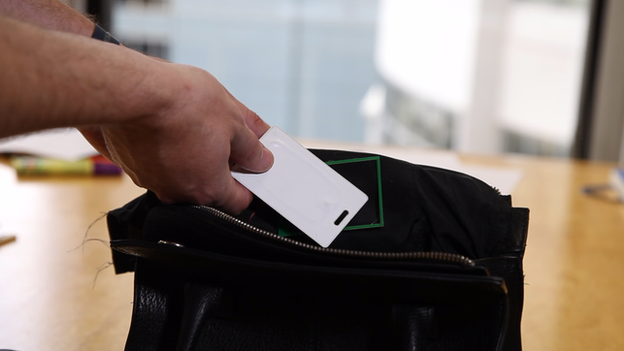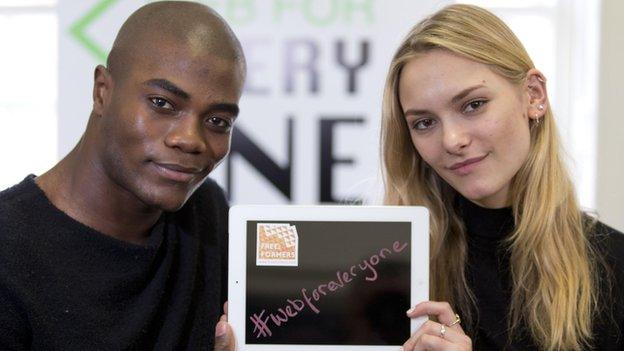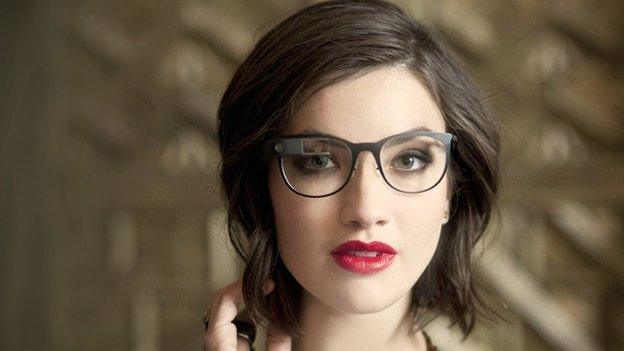Skirts made of mobile phones and programmable handbags
- Published
A show at London Fashion Week will debut the world's first skirt made of smartphones
The fashion industry has never seemed keener to make clothes fit for the digital age.
With geek chic an established fashion trend and wearable gadgets potentially the next big thing, what started as a flirtation between fashion and technology is turning into a close relationship.
Clothes industry executives are being appointed to high-profile tech firms, while mobile phone companies are literally getting their gadgets sewn into clothes.
England's capital is awash with impossibly long-legged models as the fashionistas descend for London Fashion Week so what better time to take a look at some of the hi-tech garments and accessories that have caught our eye.
Phone my skirt
One show debuted the world's first skirt made of smartphones.
Created using Nokia Lumia 1520 and 1020 handsets, the project is a collaboration between the Finnish firm, fashion designer Fyodor Golan and creative design house Kin. It took three months to complete.
Whether the world needs such a garment may be a matter for debate but there is no doubting the challenge of building one. Combining a heavy Nokia 1520 with fragile materials was problematic, and there were also issues with turning them on and maintaining battery life once attached to the skirt.
The phones each display different parts of an image to give the illusion of one big picture. The pictures change when the model moves, mimicking the way the tone of a fabric alters when it moves back and forth from light to shadow.
Annie Kearney, from Nokia Brand Lab, says that her firm has a long history of working with fashion.
"It's a technical work of art," she says.
"We wanted to experiment with the possibilities between fashion and technology.
"It's so much more than a skirt made of phones, it's playing with the idea of how tech can influence and be influenced by the world around it."
The bag that won't let you spend

The bag tracks your spending and locks you out if you hit your credit limit
Anyone who has popped out for a spot of window shopping in their lunch hour but returned to the office laden with bags may agree that a programmable handbag that locks you out when it thinks you are overspending is a pretty good idea.
The brainchild of Australian comparison site Credit Card Finder, it uses an Arduino processor and an RFID (radio-frequency identification) tag, which are mounted in the base of the bag to track your credit card spending.
The bag is also fitted with a clock and can be programmed to stay closed at your most vulnerable times of day.
When you enter a shopping "danger zone" the bag lights up with an LED warning light triggered by a GPS chip. You can also nominate a person to receive a text message if you have a spending relapse.
In many ways the iBag is anti-fashion because it is all about stopping you spending. It's design could hardly be called cutting-edge either, so it is unlikely that any of the models at London Fashion Week will be carrying one.
But it serves as an example of what happens when DIY technology meets fashion to solve a practical need.
"It is designed to help people who are really out of control with their spending," says Michelle Hutchison.
The cost of the bag may trigger some warning signals of its own - at 199 Australian dollars ($179, £107) it isn't cheap.
Members of the public are being asked to register interest. The firm says it will only put it into full-scale production if there is enough demand.
LED Hats

80,000 hats lit up the SuperBowl recently at the MetLife Stadium in New Jersey
Wearable tech hasn't yet fired up the fashion crowd's passions. Devices such as the Jawbone Up and Nike FuelBand might appeal to fitness freaks keen to track their every move but they don't exactly look great.
Canadian firm Pixmob has come up with a new way of making wearable technology cool and giving mass audience events the wow factor.
At this year's Superbowl the firm supplied each of the 80,000 ticket-holders with a hat embedded with LED technology.
During the halftime break the effect was quite literally a flash mob of pixels in which the audience became the light show.
The hats were controlled via wireless transmitters allowing PixMob to alter the colour, brightness and pulse of the lights.
At the Sochi Winter Olympics PixMob's technology was used in the opening ceremony, turning the crowd into a giant video screen via medallions around their necks.
It's certainly a novel use for wearable tech and a step-up from glow sticks or waved lighters.
Model geeks

Models BB and Stephanie learnt to code
London Fashion Week will be full of technology with models furiously tweeting each other and Instagramming from behind the scenes of the catwalk.
But the fashion world is also embracing coding as part of a national push to increase the digital skills of youngsters.
Last month Storm models joined young coders to develop a fashion app at an event organised by Free:Formers, a firm that organises computer-skill workshops to educate its clients.
The teams created a web app for a fictional event at London Fashion Week that interacted with Facebook and the ticketing service Eventbrite.
Some of the youngsters have been invited to go behind the scenes at Storm on the first day of London Fashion Week.
"I learnt about the principles of coding and I now have a general understanding of how a website can be built," model Stephanie Rad tells the BBC.
Glass makeover

Google Glass wants a more classy image
Google Glass has already had its turn on the catwalk, when it was demoed by models at New York Fashion Week back in 2012.
But most would agree that its image remains more geek than chic.
In January, Google released its Titanium Collection, a set of four stylish frames for Glass with the express purpose of de-nerding the wearable to make it appeal to a wider audience.
The frames can either be filled with dummy or prescription lenses.
It is not the only technology firm keen to show off its style credentials.
In the spring Apple will be joined by Burberry's departing chief executive Angela Ahrendts, who is set to shake up the tech firm's retail business.
In the autumn Burberry used the pre-released iPhone 5S to film a catwalk show and speculation is rife as to how Ms Ahrendts will further fuse technology and fashion.
- Published15 October 2013
- Published4 September 2013
- Published21 December 2012